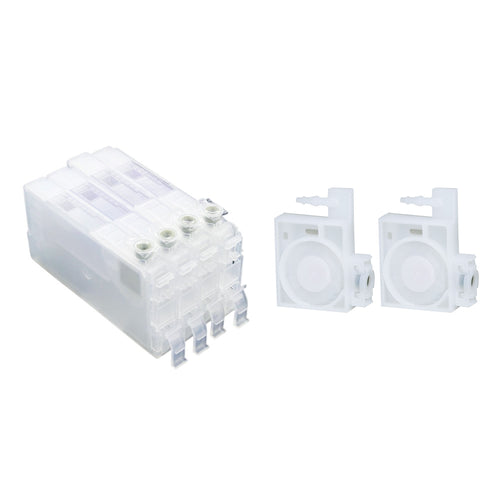DTF Printer
DTF printer
According to Google Trends data, since early 2022, interest in DTF Printers has steadily risen and even surpassed that of DTG printers by the end of 2023. In just a few short years, the DTF Printer has gone from a niche piece of equipment to a major player in the apparel decoration industry. If you're involved in T-shirt printing, branded merchandise, or any form of garment customization, now is the time to take a serious look at a commercial DTF Printer.

Why Users Are Turning to DTF Printers
Material Compatibility
One of the primary reasons users are flocking to DTF Printers is their unmatched versatility. Whether you’re creating custom T-shirts, hoodies, or even accessories, DTF Printers allow you to produce high-resolution, vibrant prints on a variety of fabrics.
Superior Print Quality and Durability
DTF Printers are designed to deliver exceptional image quality with a high level of detail and color vibrancy. Moreover, the prints produced through DTF technology are known for their durability, resisting fading and cracking even after multiple washes.
Cost-Effectiveness for Businesses of All Sizes
Another significant advantage of DTF Printers is their cost-effectiveness. For small to medium-sized businesses looking to scale operations without breaking the bank, DTF Printers offers an affordable entry point into high-quality printing.
Fast Turnaround and Increased Productivity
In the competitive world of custom apparel, speed is crucial. DTF Printers enable faster production cycles, allowing businesses to complete orders more quickly than ever before. The streamlined workflow—from printing the design on film to the heat transfer process—means less time waiting and more time generating revenue.
DTF Printer Size
DTF printers are available in sizes A1, A3, and A4. Below is an InkSonic DTF Printer model representation of the printing widths corresponding to each size:
| Printer Size | InkSonic DTF Printer models | Maximum Film Width |
| A1 | To be developed | 60cm |
| A3 | XP600 U13; R1390 C13; L1800 E13; L18058 L13 | 32cm |
| A4 | L8058 L8 | 22cm |
If you need to print larger designs, such as T-shirts, tote bags, or even banners, an A3 printer is the way to go. If you're just starting or have limited space, an A4 printer is a great option to get started.

Comparing DTF Printer to Other Methods
DTF vs. DTG Printer: Material Compatibility
DTG printing works well only on cotton fabrics, limiting choices. DTF printing works on many materials like polyester, leather, and blends. This allows businesses to offer more products and attract more customers.
DTF vs. Screen Printer
Setup Costs and Time
Screen printer needs expensive tools and materials to start. Each design requires a separate screen, which takes time to make. This process also needs skilled workers. DTF printer, however, costs less to set up. You can begin printing right away without making screens. This saves both time and money, making it great for small or custom orders.
Flexibility in Design and Order Size
DTF printer is very flexible. It handles colorful, detailed designs easily, no matter the order size. Screen printer is cheaper for big orders but struggles with small or custom jobs. DTF lets you meet different customer needs, from single items to medium-sized orders, without losing quality.
Tips for Getting Started with a DTF Printer
For businesses considering the leap into DTF printing technology, the transition may seem daunting. However, with the right approach and planning, the benefits far outweigh the initial challenges.
Research and Compare Options
Before investing, research various DTF Printer models and compare their features, costs, and reviews. Look for printers that offer scalability, user-friendly software, and strong customer support.
Understand Your Production Needs
Analyze your current production volume and forecast future growth. Choose a DTF Printer that can handle your workload efficiently. If you expect to scale quickly, investing in a printer with higher output capabilities will prevent future bottlenecks and ensure that your business can continue to grow without interruption.
Budget for Consumables and Maintenance
Factor in the cost of consumables such as inks, adhesive powders, and films when budgeting for a DTF Printer. Additionally, plan for regular maintenance to keep the machine operating at peak performance.
Invest in Training and Support
Even if you have technical expertise, investing in proper training for you and your staff is crucial. Many manufacturers offer training sessions and detailed maintenance guides to help you get the most out of your DTF Printer. The more proficient your team is in operating the equipment, the smoother your production process will be.
Choosing the Right DTF Transfer Printer
You have now gained a preliminary understanding of DTF printer. If you are interested in upgrading to a high-quality DTF printer for your clothing business, I would recommend a brand that offers both cost-effectiveness and outstanding performance—InkSonic.
Why can you trust InkSonic DTF printers?
1. Versatile and cost-effective
Each of our printer models not only guarantees high performance but also has very powerful and convenient functions(as below), but the price range is about US$2,000-3,000. It can be said that no other DTF printer on the market has the same cost-effectiveness as ours.
-
3-in-1 White Ink Circulation
-
2-in-1 Automatic Cleaning System
-
Air SuctionSmooth Film Loading System
-
2 Convertible Film Modes Sheet
2. Offer customers various model options
The InkSonic DTF printer models C, E, U, and L are designed to meet different business needs, representing economical efficiency, high efficiency, user-friendliness, and portability, respectively.
3. Reliable Brand and Support
Inksonic as a top brand provides 24/7 customer service & 12/7 technical support. Whenever you need assistance, you can email us: support@inksonic.com
Best DTF Printer Models for Beginners
InkSonic XP600 A3 DTF Printer U13

Specification
- Print Width: 13" (330 mm)
- Print Head: XP600 Single Print Head
- Print Speed: Letter/A3: 3min
- Applicable System: Windows OS
- Printing Resolution: 720 x 2880 DPI
- Printing Color: CMYK + WW
- Printing Mode: Supports Single Sheet-Fed, Roll-Fed
- Working environment: Fit all condition
-
Daily output: 200pcs/day
What does the Inksonic DTF Printer Model C E U L Stand for?
1. Inksonic DTF Printer Model C (Cost-Effective)
Target Audience: Ideal for small to medium-sized businesses with budget constraints, looking for efficiency without breaking the bank.
Business Use: Perfect for businesses that need to produce custom T-shirts in bulk, and those looking to maximize productivity without significant upfront costs.
Inksonic’s Recommendation: R1390 A3/13" DTF Printer C13
2. Inksonic DTF Printer Model E (Efficient)
Target Audience: Best suited for businesses requiring high-quality, fast prints with moderate budget flexibility.
Business Use: Ideal for businesses that demand speed and quality, such as those with larger production needs, or for areas with colder climates where ink curing is essential.
Inksonic’s Recommendation: L1800 A3/13" DTF Printer E13
3. Inksonic DTF Printer Model U (User-Friendly)
Target Audience: Businesses looking for a printer that is easy to use, with high efficiency and quality for scaling up.
Business Use: Perfect for advanced businesses or those looking to scale operations. It’s user-friendly enough for beginners but offers the features necessary for professional-grade printing.
Inksonic’s Recommendation: XP600 A3/13" DTF Printer U13
4. Inksonic DTF Printer Model L (Lightweight)
Target Audience: Small businesses or startups with limited space looking for a simple, entry-level printer.
Business Use: Best for businesses with small-scale operations or those starting in the custom printing industry.
Inksonic’s Recommendation- RocRow L18058 A3/13" DTF Printer L13
DTF Printer Maintenance Guide
1. Regular Operation: It is recommended to operate the printer at least once every three days, even if you're not actively printing. This helps prevent ink from drying up in the print head nozzles and maintains the overall functionality of the printer.
2. Moisturizer Device: If you plan to go on holiday or leave the printer unused for an extended period, consider using a moisturizer device to protect the print head. The moisturizer device helps prevent the ink from drying out and ensures the print head remains in good condition.
3. Timely Ink Refilling: Refill the ink promptly and avoid letting the ink level drop below one-third. This prevents air from entering the ink system, which can lead to printhead clogs or poor print quality. Before adding new ink, make sure to shake the ink bottle several times to prevent the ink from settling. Properly seal the remaining ink and store it in a well-ventilated area protected from light.
4. Avoid Manual Injection of Cleaning Solution: Do not manually inject cleaning solution into the print head's nozzle position using a syringe. This operation can easily damage the print head and motherboard. Follow the manufacturer's recommended cleaning procedures and use appropriate cleaning methods to ensure the longevity of your printer.
Overcoming Common Challenges
Every new technology comes with its set of challenges. Here are some common issues that businesses might face when transitioning to DTF Printer technology—and how to overcome them:
Initial Learning Curve
Like any new technology, there may be a learning curve when you first start using a DTF Printer. Ensure that you take advantage of available training resources and don’t hesitate to reach out to the manufacturer’s support team if you encounter difficulties. With time and practice, operating the printer will become second nature.
Managing Production Costs
While DTF Printers offer long-term cost savings, the initial setup and consumable costs can be a hurdle. Keep a close eye on your production expenses and adjust your pricing strategy accordingly. Transparent communication with customers about the quality and durability of your products can help justify any slight premium.
Quality Control
Maintaining consistent print quality is essential. Establish a quality control process that includes regular calibration of your printer, routine maintenance, and thorough inspections of the final products. A dedicated quality control system will help you catch any issues early and maintain the high standards that your customers expect.












































![[Pre-order] InkSonic R1390 / L1800 A3/13" DTF Printer C13A / E13A](http://www.inksonic.com/cdn/shop/files/C13A-1600_1ecb8c42-d928-4a5e-97f2-e176f6d26058.jpg?crop=center&height=20&v=1744718216&width=20)
